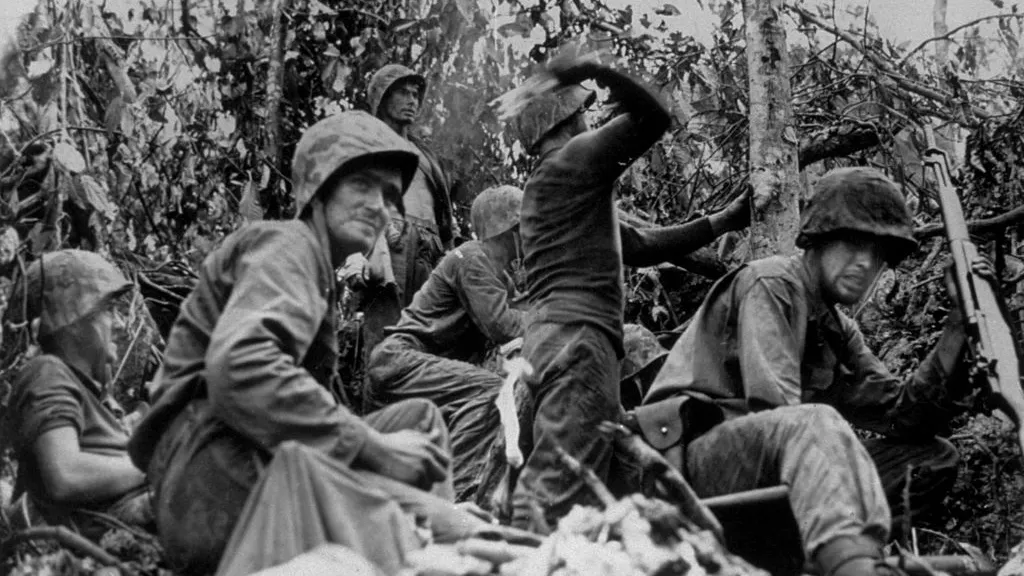When Japanese intelligence deduced that Leyte was where the next enemy blow would fall, the destination was a bit of a surprise to the high command. At first it was assumed, as MacArthur himself had pointed out to Roosevelt, that the initial target would be the large southern island of Mindanao. But during a series of carrier-launched air raids and fighter sweeps by Halsey’s marauding fleet earlier in the summer, a U.S. flier was shot down over Leyte Island. He was rescued by friendly locals and eventually returned to his ship. He reported to Halsey that Leyte appeared to be much less defended than believed.
This confirmed the admiral’s own suspicions. He’d noticed that few fighters were rising up to challenge his on-going raids on the island. Perhaps the timetable could be accelerated and Leyte, not Mindanao, should be where the first landings were made.
It was eventually decided to scrap the Mindanao operation and head straight for Leyte. MacArthur went ahead with the September 15 landing of U.S. and Australian forces on Morotai in the Moluccas, which was needed as a base to launch any blow at the Philippines. Casualties were light and the island was secured in two weeks, anchoring MacArthur’s southern flank. Unfortunately for the 1stMarine Division aboard an invasion convoy steaming 500 miles to the northeast toward the Palaus to seize an airstrip on the island of Peleliu, Nimitz decided that the operation also slated for September 15 should go forward as well.
The battle for Peleliu was expected to take just four days. Instead it degenerated into a horrific bloodbath that lasted for two months. Tragically, since Mindanao was no longer a target, the airstrip ended up being of little value, and certainly not worth the cost. The fine 1stMarine Division was decimated; the savage fighting was still raging when the first GIs landed on Leyte on October 20. 2,300 Marines and GIs fell on Peleliu with another 8,500 wounded for little benefit to the Philippines campaign already underway.
#
The accelerated time table served to find the Japanese off-balance and shuffling troops when the Americans suddenly showed up off Tacloban on Leyte’s eastern shore. MacArthur’s Imperial Army antagonist, the bullet-headed Gen. Yamashita Tomoyuki, had arrived on Luzon just ten days before the battle. His chief of staff, Lt. Gen. Muto Akira, not until after the landings had already begun. When he reported to Yamashita’s Manila office and was told of the landings, he replied: “Very interesting. But where is Leyte?”
Leyte was at the moment under the awesome guns of the largest collection of supporting surface ships since D-Day. When the first salvos of the violent pre-landing bombardment of the island began, it announced the biggest and most elaborate amphibious operation to date in the Pacific War. It is helpful here to break down the Allied dispositions to better understand the coming engagement…and the near disaster that befell MacArthur’s operations.
Supporting the landing troops of Lt. Gen. Walter Krueger’s Sixth Army, some 200,000 GIs, were two fleets, one positioned in and just outside of Leyte Gulf to cover and support the landings themselves, and the other farther out to sea to provide protection from enemy attacks and cover the northern approaches to the landing zone. The former was the U.S. Seventh Fleet under the command of Vice Adm. Thomas C. Kinkaid which was comprised of 738 vessels in all, of which 157 were combat ships, 420 amphibious, 84 patrol and 77 service ships. It was divided into three task forces: Task Force 78 and 79 were mostly the amphibious, transport and patrol vessels, while Task Force 77 contained the fleet’s hitting power in the form of surface warships to cover the landings. Task Force 77 was under Kinkaid’s personal command.
Of the many task groups that made up Task Force 77, two would play pivotal roles in the upcoming battle that no one yet suspected was just over the horizon. TG-77.2 under Rear Adm. Jesse Oldendorf consisted of six older battleships, four heavy and four light cruisers, and 15 destroyers plus an array of PT (Patrol Torpedo) boats. TG-77.4 was under the command of Rear Adm. Thomas Sprague and was made up of 18 little escort carriers, 10 destroyers, and 14 smaller escort destroyers.
The U.S. Third Fleet was commanded by Halsey. This fast, mobile strike force represented the most powerful yet put to sea. Of its several task forces, only one, Task Force 38, would be assigned to support the Leyte operation. Task Force 38 consisted of four task groups, TG 38.1, 2, 3, and 4 which combined fielded nine heavy carriers, eight light carriers, six new and fast battleships, seven heavy cruisers, 10 light cruisers, and 58 destroyers. Although nominally Task Force 38 was commanded by Vice Adm. Marc A. Mitscher aboard the carrier Lexington, with Halsey’s flag on the New Jerseyin the heart of the column the Bull would be in direct tactical as well as strategic control of whatever action awaited them.
Kinkaid and his Seventh Fleet answered directly to MacArthur on board the accompanying cruiser Nashville, whereas Halsey and his Third Fleet to Nimitz in Hawaii. Though mutually supporting, the two fleets had no overall commander other than the Joint Chiefs 10,000 miles away in Washington D.C. This ungainly structure would create confusion at a critical moment of the battle and very nearly cost the Americans dearly.
Brad Schaeffer is the author of the acclaimed World War II novel Of Another Time And Place.

.png)
.png)

